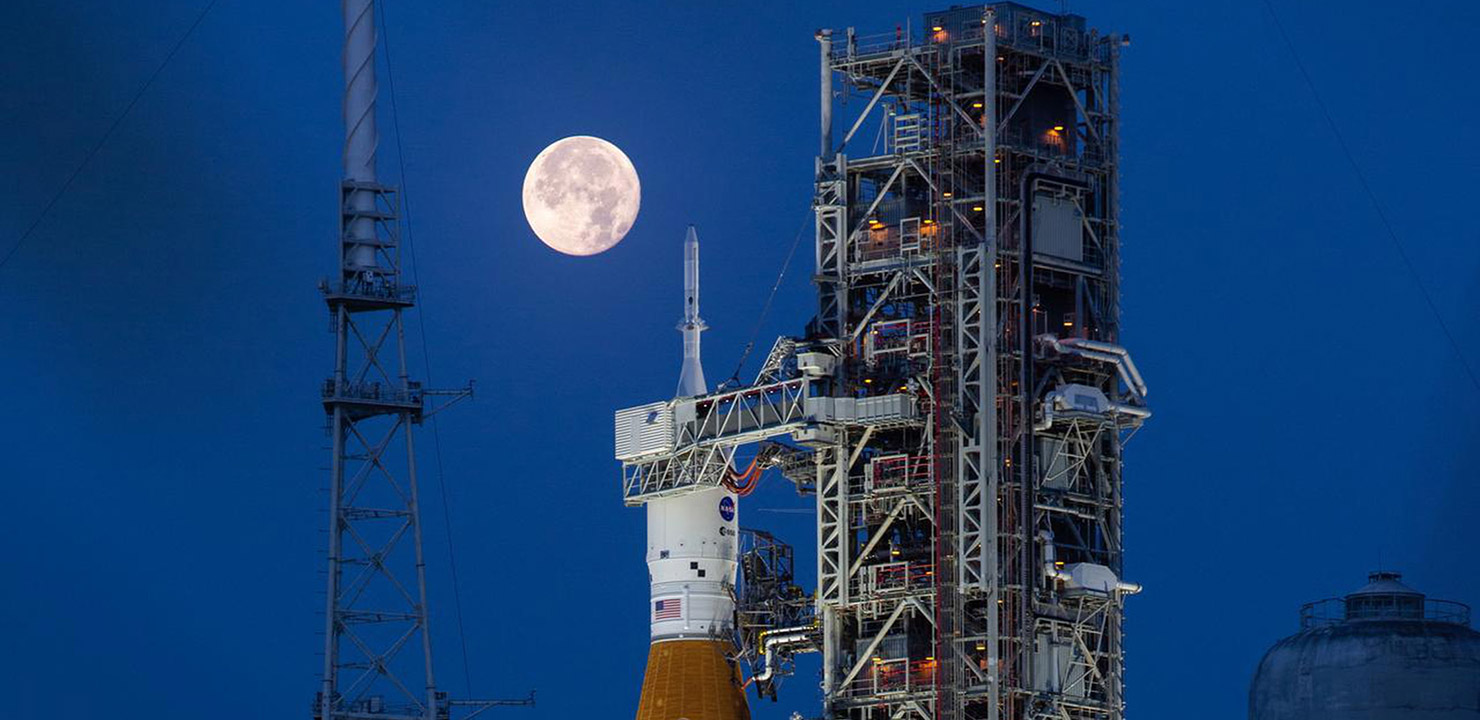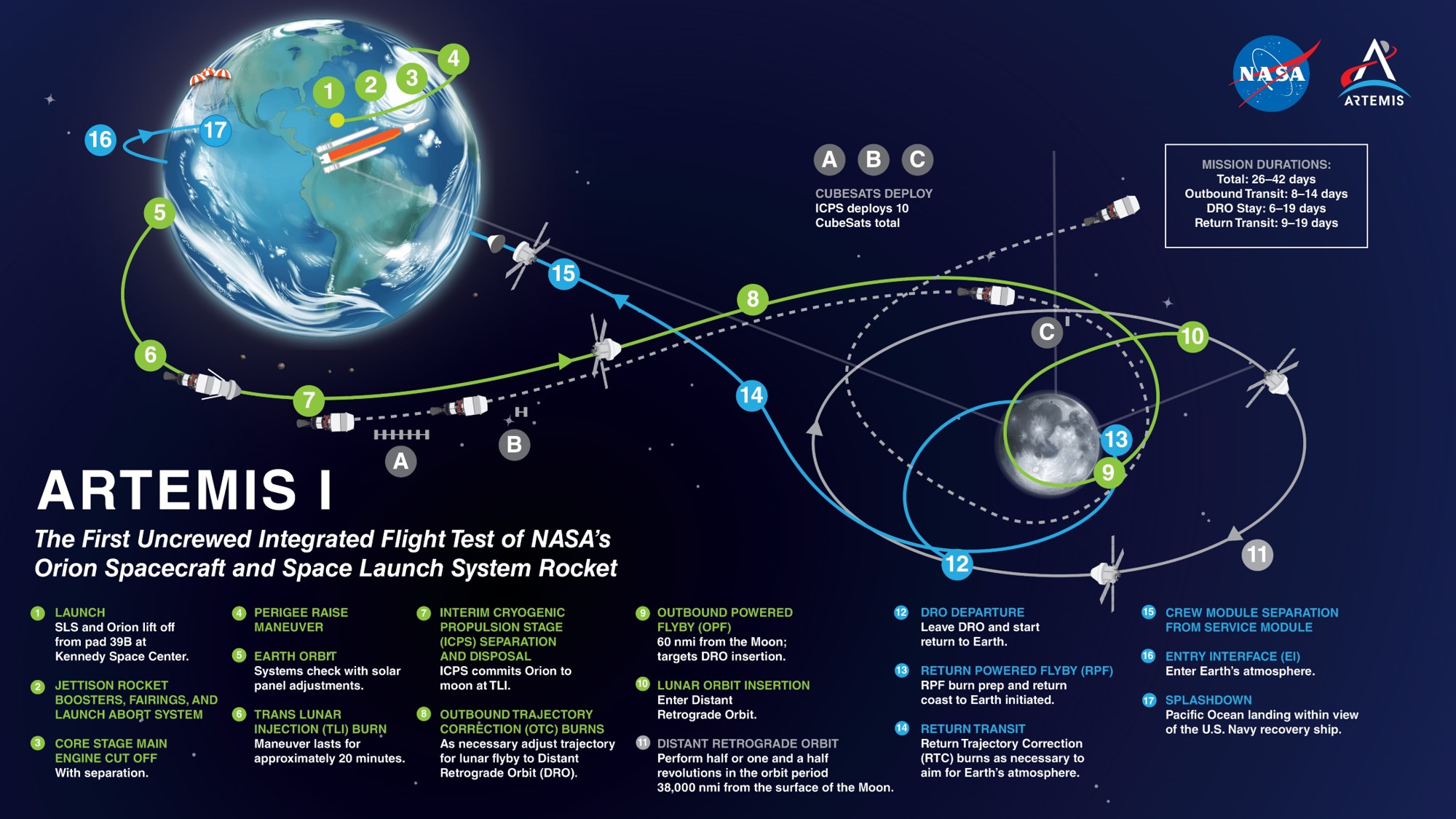
Artemis 1: A Trip Around the Moon – and Back!
August 2022 :
We are returning to the Moon - and beyond! Later this summer, NASA’s Artemis 1 mission will launch the first uncrewed flight test of both the Space Launch System (SLS) and Orion spacecraft on a multi-week mission. Orion will journey thousands of miles beyond the Moon, briefly entering a retrograde lunar orbit before heading back to a splashdown on Earth.
The massive rocket will launch from Launch Complex 39B at the Kennedy Space Center in Florida. The location’s technical capabilities, along with its storied history, mark it as a perfect spot to launch our return to the Moon. The complex’s first mission was Apollo 10 in 1968, which appropriately also served as a test for a heavy-lift launch vehicle (the Saturn V rocket) and lunar spacecraft: the Apollo Command and Service Modules joined with the Lunar Module. The Apollo 10 mission profile included testing the Lunar Module while in orbit around the Moon before returning to the Earth. In its “Block-1” configuration, Artemis 1’s SLS rocket will take off with 8.8 million pounds of maximum thrust, even greater than the 7.6 millions pounds of thrust generated by the legendary Saturn V, making it the most powerful rocket in the world!
Artemis 1 will serve not only as a test of the SLS and the Orion hardware, but also as a test of the integration of ground systems and support personnel that will ensure the success of this and future Artemis missions. While uncrewed, Artemis-1 will still have passengers of a sort: two human torso models designed to test radiation levels during the mission, and “Commander Moonikin Campos,” a mannequin named by the public. The specialized mannequin will also monitor radiation levels, along with vibration and acceleration data from inside its mission uniform: the Orion Crew Survival Suit, the spacesuit that future Artemis astronauts will wear. The “Moonikin” is named after Arturo Campos, a NASA electrical engineer who played an essential role in bringing Apollo 13’s crew back to Earth after a near-fatal disaster in space.
The mission also contains other valuable cargo for its journey around the Moon and back, including CubeSats, several space science badges from the Girl Scouts, and microchips etched with 30,000 names of workers who made the Artemis-1 mission possible. A total of 10 CubeSats will be deployed from the Orion Stage Adapter, the ring that connects the Orion spacecraft to the SLS, at several segments along the mission’s path to the Moon. The power of SLS allows engineers to attach many secondary “ride-along” mission hardware like these CubeSats, whose various missions will study plasma propulsion, radiation effects on microorganisms, solar sails, Earth’s radiation environment, space weather, and of course, missions to study the Moon and even the Orion spacecraft and its Interim Cryogenic Propulsion Stage (ICPS)!
If you want to explore more of the science and stories behind both our Moon and our history of lunar exploration, the Night Sky Network’s Apollo 11 at 50 Toolkit covers a ton of regolith: bit.ly/nsnmoon! NASA also works with people and organizations around the world coordinating International Observe the Moon Night, with 2022’s edition scheduled for Saturday, October 1: moon.nasa.gov/observe. Of course, you can follow the latest news and updates on Artemis 1 and our return to the Moon at nasa.gov/artemis-1
This article is distributed by NASA Night Sky Network. The Night Sky Network program supports astronomy clubs across the USA dedicated to astronomy outreach. Visit nightsky.jpl.nasa.gov to find local clubs, events, and more!

Full Moon over Artemis-1 on July 14, 2022, as the integrated Space Launch System and Orion spacecraft await testing. Photo credit: NASA/Cory Huston Source: https://www.nasa.gov/image-feature/a-full-moon-over-artemis/



